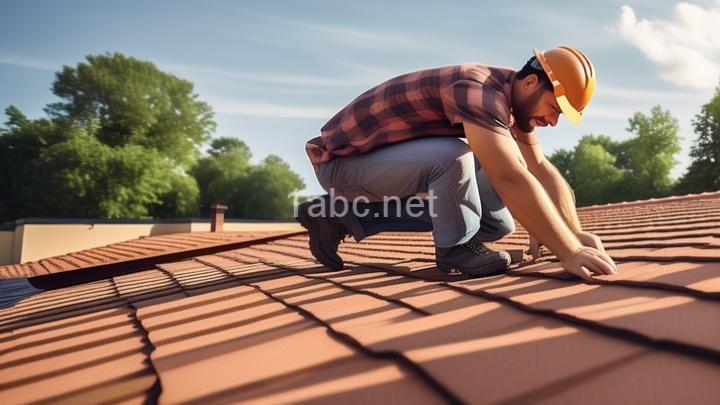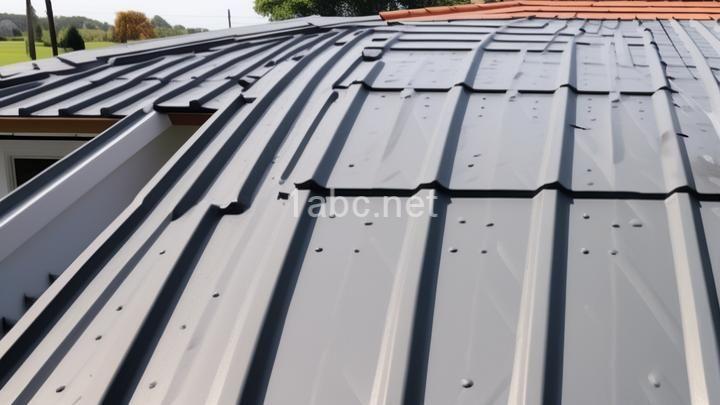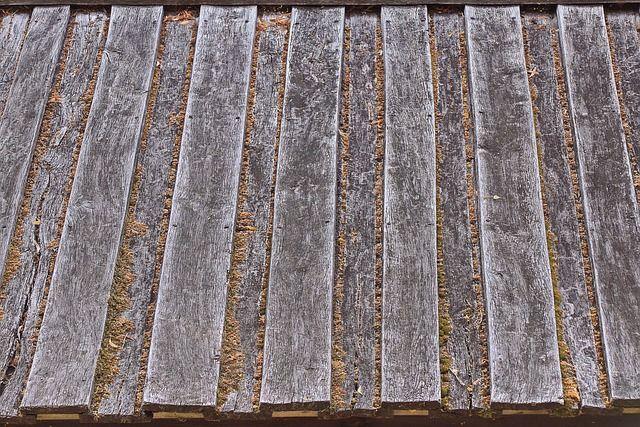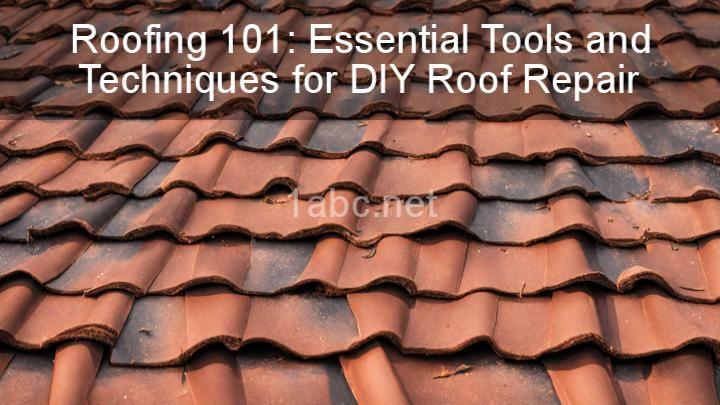Roof Maintenance 101: A Step-by-Step Guide for Beginners

Introduction:
Welcome to our friendly guide on roof maintenance! In this step-by-step guide, we will walk you through the basics of taking care of your roof. Whether you're a new homeowner or just looking to learn more, this guide is perfect for beginners.
I. Understanding the Importance of Roof Maintenance
Taking care of your roof is essential to ensure its longevity and protect your home from potential damage. Regular roof maintenance offers a multitude of benefits, such as preventing leaks, extending the lifespan of your roof, and avoiding costly repairs down the line. Neglecting your roof can lead to serious issues, including water damage, mold growth, and even structural damage to your home.
II. Inspecting Your Roof
To properly maintain your roof, it's important to conduct regular inspections. Here's a step-by-step process to help you get started:
1. Checking for visible damage and signs of wear and tear:
Grab a sturdy ladder and climb up to your roof. Look for any cracked, curled, or missing shingles. Pay attention to areas where the roof meets other structures, such as chimneys and vents, as these are common areas for leaks to occur. Take note of any signs of wear and tear, such as granule loss or mold growth.
2. Examining the gutters and downspouts:
Inspect your gutters and downspouts for any debris or blockages. Clean them out as necessary to ensure proper water flow. Clogged gutters can lead to water backup, which can damage your roof and cause leaks.
3. Looking for leaks or water damage inside your home:
Check your attic for any signs of leaks or water damage. Look for dampness, stains, or mold growth on the ceiling and walls. If you notice any issues, it's important to address them promptly to prevent further damage.
III. Cleaning Your Roof
Regular cleaning is an essential part of roof maintenance. Here are some safe methods to clean different types of roofs:
1. Asphalt shingles:
Use a soft-bristle brush or a low-pressure power washer to remove debris and algae growth. Avoid using high-pressure washers, as they can damage the shingles.
2. Metal roofs:
Gently sweep away loose debris with a broom or use a low-pressure power washer to remove dirt and grime. Avoid abrasive materials that can scratch the surface.
3. Tile roofs:
Use a soft-bristle brush or a low-pressure power washer to clean the tiles. Avoid walking directly on the tiles to prevent breakage.
IV. Repairing Minor Issues
Identifying and addressing minor issues early on can prevent them from turning into more significant problems. Here are some common minor issues you might encounter:
-
Cracked or missing shingles/tiles:
Replace any damaged or missing shingles or tiles to maintain the integrity of your roof. -
Loose flashing or vents:
Inspect the flashing around chimneys, vents, and skylights. Tighten or replace any loose or damaged flashing to prevent leaks. -
Damaged sealant around chimneys or skylights:
Check for cracks or gaps in the sealant around chimneys and skylights. Remove any old sealant and reapply a new layer to ensure a watertight seal.
V. Hiring Professional Help
While regular maintenance can be done by homeowners, there are instances where it's best to call a professional roofer. Here are some signs that indicate it's time to seek professional help:
- Extensive damage or significant leaks
- Structural issues with your roof
- Lack of experience or knowledge in roof repairs
When hiring a professional, it's crucial to find a reliable roofing contractor. Ask for recommendations from friends, family, or neighbors, and always check their credentials and customer reviews.
VI. Preventive Measures
In addition to regular maintenance, there are preventive measures you can take to protect your roof:
-
Maintain healthy trees around your property:
Trim branches that hang over your roof to prevent them from scraping against the surface during storms. Remove any dead or weak branches that could potentially fall and damage your roof. -
Keep gutters clean and free from debris:
Regularly clean your gutters to prevent clogs and ensure proper water flow. Install gutter guards to minimize the amount of debris that accumulates. -
Regularly trim overhanging branches:
Trim branches that hang over your roof to prevent them from scraping against the surface during storms. Remove any dead or weak branches that could potentially fall and damage your roof.
VII. Seasonal Roof Maintenance Checklist
To keep your roof in excellent condition throughout the year, follow this seasonal maintenance checklist:
-
Spring: Inspect your roof after winter's harsh conditions. Look for any damage caused by ice dams, strong winds, or heavy snow.
-
Summer: Check for potential heat-related issues, such as blistering or curling shingles. Ensure proper ventilation to prevent heat buildup in your attic.
-
Fall: Clean out your gutters and downspouts to prepare for the upcoming rainy season. Inspect your roof for any loose or damaged shingles before the winter months.
-
Winter: Protect your roof from ice dams and snow buildup by removing snow when necessary. Ensure proper insulation and ventilation to prevent ice formation.
Conclusion:
Congratulations! You've now learned the basics of roof maintenance. By following this step-by-step guide, you can ensure your roof remains in good condition for years to come. Remember, regular maintenance is key to avoiding costly repairs. If you have any questions or need further assistance, feel free to reach out to us. Happy roof maintenance!
FREQUENTLY ASKED QUESTIONS
What is the purpose of this guide?
The purpose of this guide is to provide you with valuable information and guidance on various topics. Whether you're seeking advice on fashion, beauty, lifestyle, or any other area of interest, this guide aims to offer helpful insights and tips to enhance your knowledge and improve your overall experience. Our goal is to assist you in making informed decisions, while also providing a touch of entertainment and inspiration along the way. So, sit back, relax, and let this guide be your go-to resource for all things fabulous and fun!
Do I need any prior experience or knowledge to use this guide?
No, you do not need any prior experience or knowledge to use this guide. It is designed to be beginner-friendly and provides step-by-step instructions to help you navigate through the process smoothly. Whether you're a novice or have some experience, this guide will be easy to follow and understand. So, don't worry if you're starting from scratch - we've got you covered!
How often should I perform roof maintenance?
To ensure that your roof remains in good condition, it is recommended to perform regular roof maintenance. The frequency of maintenance depends on various factors such as the age of your roof, the type of roofing material used, and the climate in your area. In general, it is advisable to inspect your roof at least once a year. This inspection can help you identify any potential issues such as loose or damaged shingles, clogged gutters, or leaks. Additionally, after severe weather events like storms or heavy winds, it is a good idea to check your roof for any signs of damage.
However, it's important to note that some roofs may require more frequent maintenance. For example, if you have a flat roof or a roof with low-sloped areas, you may need to inspect it more often to prevent water pooling and potential leaks.
Regular roof maintenance can help extend the lifespan of your roof and prevent costly repairs down the line. If you're unsure about the specific maintenance needs of your roof, it's always a good idea to consult with a professional roofing contractor who can provide expert advice tailored to your roof's unique requirements.
What are some signs that indicate my roof needs maintenance?
There are several signs that indicate your roof may need maintenance. Here are some common ones to look out for:
-
Leaks: If you notice water stains on your ceiling or walls, it could be a sign of a leaky roof. Pay attention to any dampness or water pooling in your attic as well.
-
Missing or damaged shingles: If you see shingles that are cracked, curled, or completely missing, it's a clear indication that your roof needs attention. These issues can lead to further damage if not addressed promptly.
-
Granule loss: Take a look at your gutters or downspouts for an excessive amount of granules. Shingles naturally shed some granules over time, but an excessive amount could indicate wear and tear that requires maintenance.
-
Sagging or drooping: If you notice any areas on your roof that appear to be sagging or drooping, it could be a sign of underlying structural damage. This should be addressed immediately to prevent further problems.
-
Mold or moss growth: The presence of mold or moss on your roof can indicate moisture-related issues. These growths can cause damage to your roof if left untreated, so it's important to address them promptly.
-
Increased energy bills: If you notice a sudden increase in your energy bills, it could be a sign that your roof is not providing proper insulation. This may be due to damaged or deteriorating roofing materials.
If you observe any of these signs, it's recommended to contact a professional roofing contractor to assess the condition of your roof and determine the necessary maintenance or repairs. Regular roof inspections and maintenance can help prolong the lifespan of your roof and prevent more extensive damage in the long run.


